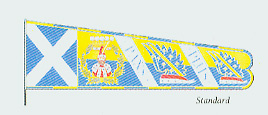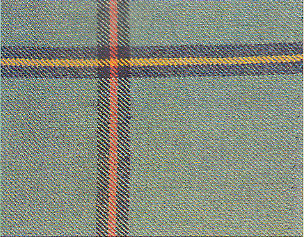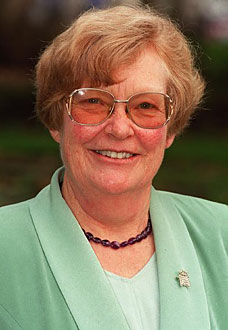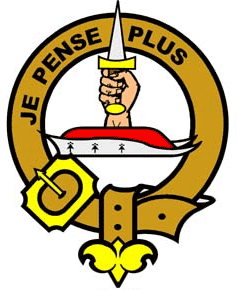History
Mar History
Mar was one of the seven ancient king-doms or provinces of Scotland whose rulers were known by the title of ‘mormaer’. Its territory lay in that part of Aberdeenshire largely between the Rivers Don and Dee. Donald, Mormaer of Mar, fought at the Battle of Clontarf, where the High King of Ireland, Brian Born, drove back the invading Norsemen in 1014. In the charter erecting the Abbey of Scone in 1114, the Mormaer of Mar is named as Rothri, and he is given the latin title ‘Comes’ which generally equates to the modern rank of earl. Rothri was succeeded by Morgund, second Earl of Mar, who witnessed, some time before 1152, charters to the Abbey of Dunfermline. William, the fifth Earl, was one of the Regents of Scotland and Great Chamberlain of the Realm in 1264. His son, Donald, was knighted at Scone by Alexander III in September 1270. He witnessed the mar-riage contract of Princess Margaret of Scotland with King Eric of Norway, and later acknowl-edged Eric’s daughter, Margaret, the Maid of Norway, as the lawful heir to the throne. When the child died at Orkney on her way to claim her kingdom, events were set in motion which were ultimately to lead to the field of Bannockburn.
The Earls of Mar supported the Bruce claim to the throne, and Donald’s eldest daughter, Isabel of Mar, became the first wife of Robert the Bruce. Her brother, Gratney, the seventh Earl, married Robert’s sister, Christian, further strengthening the Bruce alliance. Gratney died around 1305, leaving an only son, Donald, to succeed to the earldom. He was captured at Methven in 1306 and taken as a hostage to England, where he remained in captivity throughout the struggle for Scotland’s freedom. He was released after the victory at Bannockburn, when several pris-oners, including the wife, sister and daughter of King Robert, were exchanged for the Earl of Hereford. In 1332 Mar was chosen to be regent of the kingdom, a post he held for only ten days. On the eve of his election, Edward Balliol appeared in the Forth with an English fleet. Meeting little opposition, Balliol marched into Perth while Mar hurriedly gathered his troops to confront the invaders on the banks of the River Earn. Balliol’s forces were heavily outnumbered, but the Scots army lacked disci-pline and effective leadership. In the dead of night, on 12 August 1332, the English crossed the river by a secret ford and fell upon the Scots army in their sleep, routing them totally. The Earl of Mar was among the fallen. Thomas, the ninth Earl, died without issue, and the title passed to his sister, Margaret, and through her, to her daughter, Isabel. She took as her second husband Alexander Stewart, the natural son of the feared Wolf of Badenoch. She granted the life-rent of the earldom to her Stewart husband, but reserved succession to her own lawful heirs. She died without issue around 1407, and her kinsman, Robert, a descendent of Elyne, daughter of the seventh Earl, became ‘de jure’ thirteenth Earl of Mar. His son, Thomas, was denied his lawful title when James II claimed the earldom through the alleged rights of Alexander Stewart, Countess Isabel’s husband. The title was then bestowed firstly on the king’s son, Prince John, and later, in 1562, on James Stewart, the illegitimate half-brother of Mary, Queen of Scots. In 1565 Queen Mary granted a charter to John, eighteenth Earl, restoring the title. The queen declared that she was ‘moved by conscience to restore the lawful heirs to their just inheritance of which they have been kept out by obstinate and partial Rulers and Officers’.
John, the twentieth Earl, was appointed governor of Edinburgh Castle in 1615. He was also a judge of the Supreme Court until 1630. The earls were not supporters of Charles l’s religious policies, but when it became clear that support of the Covenant meant armed opposition to the king, both the earl and his eldest son, John, Lord Erskine, took up arms in the royalist cause. The earl entertained Montrose in 1645 in his castle at Alloa. Lord Erskine accompanied the king’s captain gen-eral and rode at the Battle of Kilsyth in August 1645. The family estates were forfeited until Charles II came to the throne in 1660. Charles, the twenty-second Earl, raised the 21st Regiment of Foot, or Royal Scots Fusiliers, in 1679, and became its first colonel. John, the twenty-third Earl, was created Duke of Mar in 1715 by the exiled James VIII, although for his Jacobite loyalties all his Scottish honours were ultimately forfeited. The earldom was restored to John, twenty-fourth of Mar, by Act of Parliament in 1824. In 1875 the House of Lords ruled that the title of Earl of Mar claimed by Walter Erskine, twelfth Earl of Kellie, was different from the ancient dignity of Mar. There is accordingly an Earl of ‘Mar and Kellie’, the chief of the Erskines, who should not be confused with the Countess of Mar.
Scottish Clan & Family Encyclopedia, 1998 Barnes & Noble Books
Mormaers of Mar and Earls of Mar
The Mormaers of Mar
[Prior Mormaers of Mar unknown to history or legend]
Melbridga (about 890)
?
Cainnech (?)
Emin (or Emkin) MacCainnech (before 1014)
Donald (Domhnall) MacEmin (died 1014, Battle of Clontarf)
Martachus (? – 1065 – ?)
Gratnach (or Gartnait or Gratney) (son of Martachus?) (?)
?
The Earls of Mar
Ehislach?
Ruadri (or Rothri or Roderick) (MacEmin or Ehislach) – 1st Earl (? – 1114 – 1141?)
Gillocher (or Gylocher or Gille Chlerig) (Ehislach) – Not numbered (1140s)
Morgund (or Morgan or Morggán) MacGylocher (Ehislach) – 2nd Earl (died before 1183)
Gilchrist (Gille Crist) (probably not Morgund’s son) – 3rd Earl (died about1203)
Duncan (Donnchadh) MacGylocher (Ehislach) – 4th Earl (died about 1244)
William (Uilleam) MacGylocher (Ehislach) – 5th Earl (died 1276 or 1281)
Donald (Domhnall) MacGylocher (Ehislach) – 6th Earl (died 1295 or 1297 or 1301)
Gratney (Gartnait) MacGylocher (Ehislach) – 7th Earl (died about 1305)
Donald (Domhnall) MacGylocher (Ehislach) – 8th Earl (died 1332)
Thomas MacGylocher (Ehislach) – 9th Earl (died 1374 or 1377)
Margaret MacGylocher (Ehislach) – 10th Countess (died 1391 or 1393)
Douglas
William Douglas – Not numbered (because Earl by marriage) (died 1384)
James Douglas – Not numbered (even though son of Margaret of Mar) (died 1388)
Isabel Douglas (Sister to James) – 11th Countess (born 1360 – died 1408)
Drummond
Malcolm Drummond – Not numbered (because Earl by marriage) (died 1402)
Stewart
Alexander Stewart – Not numbered (because Earl by marriage) (died 1435)
Erskine
Robert Erskine – De Jure 12th Earl (died 1452)
Thomas Erskine – De Jure 13th Earl (died 1493)
Alexander Erskine – De Jure 14th Earl (died 1509)
Robert Erskine – De Jure 15th Earl (died 1513)
John Erskine – De Jure 16th Earl (died 1552)
John Erskine – De Jure 17th Earl, De Facto after 1565 (died 1572)
John Erskine – 18th Earl (died 1634)
John Erskine – 19th Earl (died 1653)
John Erskine – 20th Earl (died 1688)
Charles Erskine – 21st Earl (died 1689)
John Erskine – 22nd Earl [1715 Duke of Mar-Jacobite title] (died 1732)
Thomas Erskine – Not numbered (died 1766)
Frances Erskine – Not numbered (died 1776)
John Frances Erskine – 23rd Earl (died 1825)
John Frances Erskine – 24 th Earl (died 1828)
John Frances Miller Erskine – 25th Earl (died 1866)
Goodeve-Erskine
John Frances Goodeve Erskine – 26th Earl (died 1930)
Johnn Francis Hamilton Erskine – 27th Earl (died 1932)
Young
Lionel Walter Young – 29th Earl (died 1965)
Lane
James Clifton Lane – 29th Earl (resigned 1975)
Margaret Alison Lane – the R. H. the Countess of Mar – 30th Countess (born 1940 – current)
Heir Presumptive: Susan Helen – Mistress of Mar (born 1963)
Lady Susan’s Heir Presumptive: Isabel Alice – Isabel of Mar (born 1991)
Our Chief
Margaret of Mar, 31th Holder of the Earldom (born 19 September 1940) is a crossbench member of the House of Lords, an elected hereditary peer and the holder of the original Earldom of Mar, the oldest peerage title in the United Kingdom. She is the only suo jure Countess in the House of Lords.
Early life
She was born Margaret Alison Lane, the daughter of James Lane, Master of Mar, the Heir Presumptive of Lionel Erskine-Young, 29th Earl of Mar, his first cousin once removed (both were descended from a sister of John Goodeve-Erskine, 27th Earl of Mar).
Lane had two younger siblings: David Charles Lane, and Janet Helen Lane. As the 29th Earl was childless and unmarried, and not expected to father children in the future, it was expected that her father and brother would both in their turn succeed to the Earldom (and the Chiefship of the Name and Arms of Mar), and so her father changed his and his son’s surname to “of Mar” in 1959.
Mistress of Mar
Lane’s father succeeded as 30th Earl of Mar in 1965; she became known as Lady Mar, and her brother became known as Lord Garioch. However, Lord Garioch died young in 1967. Thus, Margaret became Heiress Presumptive and became known as The Mistress of Mar. Her surname was then changed to “of Mar” shortly afterwards.
Countess of Mar
In 1976, the 30th Earl died and the Mistress of Mar became the 31st Countess of Mar. Thus she entered the House of Lords. With the House of Lords Act 1999, Lady Mar normally would have been removed from the House of Lords. However, the Act provided that ninety-two hereditary peers would be elected to the House. Lady Mar was among the hereditary peers chosen to serve, and is the only suo jure Countess in the House of Lords as of 2005. She sits as a cross-bencher, meaning she is not aligned with any particular political party.
As Countess of Mar she is also Titular 11th Duchess of Mar in the Jacobite Peerage (in which Peerage she is numbered as 32nd Countess of Mar, as the attainder of 1716-1824 is not recognised by Jacobites).
Note: Owing to a nineteenth-century dispute, there is another Earl of Mar, James Thorne Erskine, 14th Earl of Mar and 16th Earl of Kellie. Even so, the Lady Margaret is the rightful heiress of Mar.
Family
Lady Mar has married three times, first to Edwin Noel Artiss, then to John Salton, and finally to John Jenkin. From the first marriage she had a daughter: Susan Helen of Mar, Mistress of Mar (born 1963), the heiress presumptive to her mother’s peerages. Lady Susan is married to Bruce Alexander Wyllie, and has two daughters, Isabel and Frances, the former of whom will likely succeed as Countess of Mar after her mother and grandmother.
Titles from birth
• Miss Margaret Lane (19 September 1940 – 30 May 1959)
• Mrs Margaret Artiss (30 May 1959 – 1965)
• Lady Margaret Artiss (1965 – 8 January 1967)
• Lady Margaret of Mar, Mistress of Mar (8 January 1967 – 21 April 1975)
The Erskines
Clan Erskine is a Lowland Scottish clan.
Origins of the Name
Erskine is an area to the south of the River Clyde and ten miles to the west of Glasgow. The name is believed to be ancient or Old British for green rising ground. In the 13th century during the reign of King Alexander II of Scotland the first known person of the name Erskine was Henry Erskine who was also the owner of the Barony of Erskine.
In modern Scottish Gaelic, the name is spelt “Arascain”.
Wars of Scottish Independence
During the Wars of Scottish Independence the Clan Erskine were supporters of King Robert the Bruce.
15th Century
In 1435 Alexander Stewart, the Earl of Mar died and Sir Robert Erskine claimed the title. this also made him the chief of Clan Mar. However the King withdrew the earldom in 1457 stating that it could only belong to a Royal Stuart. Ten years later Sir Robert was created the first Lord Erskine. This unlawful succession was finally interrupted by Mary, Queen of Scots, who saw that the rightful heir John Erskine, 17th Earl of Mar was restored.
16th century & Anglo Scottish Wars
During the Anglo-Scottish Wars the 4th ‘Lord Erskine’ led the Clan Erskine at the Battle of Flodden Field in 1513 where he was slain.
Mary Queen of Scots had been in the care of the 5th Lord Erskine and when he died she made John Eskine the 6th Lord Erskine the Earl of Mar: John Erskine, 17th Earl of Mar.
18th century & Jacobite Uprisings
At the beginning of the Jacobite Uprisings it seemed likely that the Erskines would support the British government. However the chief of Clan Erskine, John Erskine, 22nd Earl of Mar had traveled to London in 1714 expecting the post of Secretary of State of Scotland. However he was not given the job and as a result he became a Jacobite. He then raised an army of over ten thousand men for the Jacobite cause. This force was not used to its potential during the Battle of Sheriffmuir on 13 November 1715 where the Jacobites were defeated. The Earl of Mar then fled Scotland to Saint-Germain in France, whereupon he betrayed his Jacobite associates. He lost his line of the Earldom of Mar and it was not restored until 1824.
Clan Chief
The current Chief of Clan Erskine is James Erskine, 14th Earl of Mar who descends from the Earls of Mar, seventh Creation (1565) (as deemed by the House of Lords in 1875).
It should be noted that the Clan Mar now has a separate chief; Margaret of Mar, 30th Countess of Mar who descends from the Earls of Mar, first Creation.
Clan Castles
• The House of Dun and the Dun Estate was home to the Clan Erskine family from 1375 until 1980, but archaeological evidence shows that people have lived here for at least 9,000 years. John Erskine of Dun was a key figure in the Scottish Reformation.
• Kildrummy Castle was the seat of the Clan Erskine until it was abandoned after the failed Jacobite Uprisings in 1716.
• Corgarff Castle was acquired by John Erskine, 18th Earl of Mar in 1626.
• Kellie Castle was purchased by Sir Thomas Erskine in 1613.
• Dryburgh Abbey was given to the Earl of Mar by King James VI of Scotland in 1544.
• Alloa Tower
• Dirleton Castle
• Braemar Castle
• Rosslyn Castle
The Castles of Mar
Braemar Castle is a castle near Braemar in the Aberdeenshire region of Scotland.
The first tower of Braemar Castle was constructed in 1628 by John Erskine, the 7th Earl of Mar to replace the older Kindrochit Castle. An important garrison during the Jacobite uprising, Braemar was attacked and burned by John Farquharson, the Black Colonel of Inverey in 1689, killing John Erskine. The castle was left in ruins until 1748 when it was leased to the government by Clan Farquharson of Invercauld, now to serve as a garrison for Hanoverian troops. In some rooms, graffiti left by the English soldiers can still be seen.
In 1797 the castle was returned to the Farquharson clan and its restoration for use as clan seat begun. The 12th Laird of Invercauld entertained Queen Victoria there while she attended the Braemar Gathering.
It is an L plan castle with a star-shaped curtain wall and three storey angle turrets. The main entrance to the castle retains an original iron yett.
Among the antiques on display within the castle are a Bronze Age sword, the world’s largest cairngorm crystal, a rare specimen of blue topaz and a piece of tartan plaid once worn by Bonnie Prince Charlie.
Today, the castle is regarded as the ancestral home of the Farquharson clan and is still owned and occupied by them. Areas of the main building including its dungeons are open to tourists all year round, and the castle chapel and dining room may be rented for weddings and small functions.
Kildrummy Castle is a ruined castle near Kildrummy, in Aberdeenshire, Scotland. Though ruined, it is probably the most extensive castle of 13th century date to survive in eastern Scotland, and was the seat of the Earls of Mar.
Dating from the early 13th century, the castle is believed to have been constructed during the lordships of Uilleam and Domhnall, Earls of Mar. It has been besieged a number of times in its history, first in defence of the family of Robert the Bruce in 1306, and again in 1335 by David of Strathbogie. On this occasion Christina Bruce held off the attackers until her husband Sir Andrew Moray came to her rescue.
In 1374 the castle’s heiress Isobel was seized and married by Alexander Stewart, who then laid claim to Kildrummy and the title of Earl of Mar. In 1435 it was taken over by James I, becoming a royal castle until being granted to Lord Elphinstone in 1507.
The castle passed from the Clan Elphinstone to the Clan Erskine before being abandoned in 1716 following the failure of the Jacobite rebellion.
Kildrummy Castle is “shield-shaped” in plan with a number of independent towers. The flat side of the castle overlooks a steep ravine; and on the opposite side of the castle the walls come to a point, which was once defended by a massive twin-towered gatehouse. The castle also had a keep, called the Snow Tower, taller than the other towers, built in the French style, as at Bothwell Castle. Extensive earthworks protected the castle, including a dry moat and the ravine. Most of the castles foundations are now visible, along with most of its lower-storey walls. Archaeological excavations in 1925 uncovered decorative stone flooring and evidence of battles.
Today, the remains of the castle are owned by Historic Scotland. A hotel (the Kildrummy Castle Hotel) has been built on the old estate, overlooking the ruins.
Just outside the village of Glamis, north of Dundee. Glamis is still the family home of the Earls of Strathmore, but is open to the public. Open May to September daily except Sunday
The family home of the Earls of Strathmore since 1372, when Robert II of Scotland gave the castle to Sir John Lyon.
It is the setting for Shakespeare’s Macbeth and is refereed to specifically :- “Glamis thou art” “and yet woulds’t wrongly win: thou’dst have great Glamis” It is popularly believed that Duncan was murdered here by Macbeth
Legends and myths have grown around the castle. King Malcolm II was said to have been murdered here in the 11th century. Lady Janet Douglas, widow of the Earl of Glamis, was burned at the stake as a witch in 1540 by James V. There is said to be a secret room where a nobleman played cards with the devil himself.
Glamis today looks more like a French Chateau than a medieval fortress, because it was extensively restored in the 17th and 18th centuries. The original tower house remains at the centre of the castle today
It has, of course, close connections with the present Royal Family, being the childhood home of Queen Elizabeth the Queen Mother ( she being the youngest daughter of the 14th Earl), and Princess Margaret was born here in 1930
Brechin Castle stands proud on a massive bluff of rocks above the River Southesk on the site of a much older fortress belonging to the Scottish kings. The present house was last reconstructed in the early1700’s and incorporates parts of the original Castle dating back to the 13th century. The building has evolved from a defensive role to its present great house style.
Brechin Castle is steeped in history. In 1296 Edward I received the submission of John Baliol there and in 1303 Sir Thomas Maule defended the castle against the English for three weeks until his own death brought about its surrender. In 1643 Patrick Maule, 1st Earl of Panmure, bought the whole of the Brechin Property from the Earl of Mar. The Castle was at that time a simple L shaped house of three storeys. It was the 4th Earl of Panmure, married to Margaret daughter of the 3rd Duke of Hamilton, who eventually rebuilt the Castle as it is today.
Lord Dalhousie represents two families who have for many centuries been illustrious in the history of our country, the Maules of Panmure in Angus and the Ramsays of Dalhousie in Midlothian, both families of Norman origin who came to England about the time of the Conqueror, and subsequently obtained grants of land in Scotland.
It was soon after the Abbey of Aberbrothock (Arbroath) was founded by King William the Lion in 1178, that the Maules were established in Panmure and Barry through the marriage of Christian, heiress of Panmure, with Sir Peter Maule.
A crisis in the history of the Family, as in many ennobled Scottish families, occurred after the rebellion of 1715. James, the 4th and last Earl of Panmure in the Scottish Peerage, took part in the rebellion, and died in exile in France. His estates were forfeited, but his wife obtained a long lease of Brechin Castle from the purchasers, the York Buildings Company, and the Earl’s brother, Harry Maule, who also had taken part in the rebellion, was allowed by the Government to return to Scotland from his refuge in Holland, and obtained a lease of Brechin Castle.
Harry Maule’s surviving son, William, was created an Irish Peer in 1743 and took the title the Earl of Panmure but this time in the Irish rather than the Scottish peerage. He bought back the estate from the creditors of the York Buildings Company which had gone into liquidation. He died unmarried in 1782. His eldest sister, Jean Maule had married George, Lord Ramsay, the eldest son of William, 6th Earl of Dalhousie whose home was Dalhousie Castle in Midlothian. It was thus, by this marriage, that the Panmure Estates passed into the Dalhousie Family.
On the death of George, 8th Earl of Dalhousie, his second son, William Ramsay assumed the property, arms and name of Maule of Panmure. As William Maule he was active in politics and in 1831 was granted a peerage of Great Britain, becoming Baron Panmure of Brechin and Navar.
Another notable member of the Family was James Andrew, 10th Earl of Dalhousie, also made Marquis of Dalhousie in recognition of his service as Governor General of India. Having no son he was succeeded by Fox Maule, the son of William Maule as 11th Earl of Dalhousie. Fox Maule was a notable statesman had no sons and, on his death the title passed to George Ramsay, grandson of the 8th Earl, in 1875 following a distinguished career in the Royal Navy in which he served as an Admiral. He died at Dalhousie Castle in July 1880 and was buried in the family vault at Cockpen, Midlothian.







